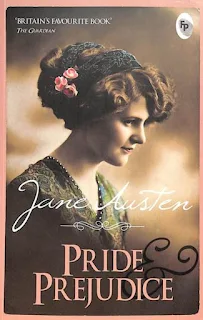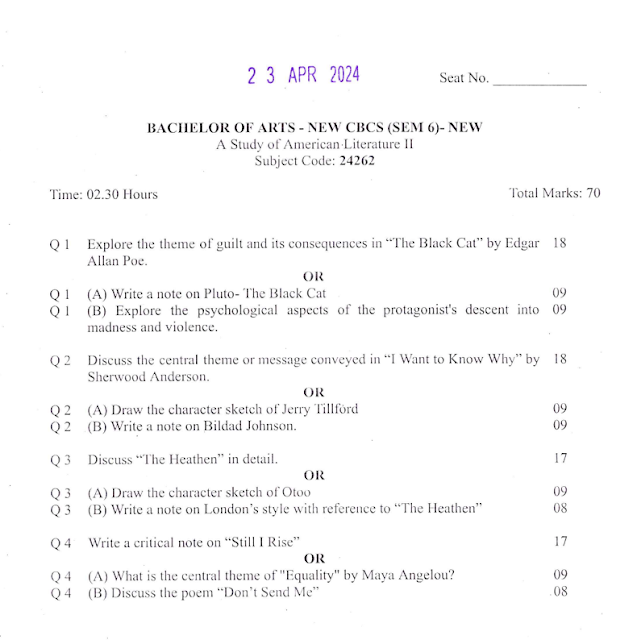Pride & Prejudice
by Jane Austen
This blog is in answer to questions given in the Thinking activity which was assigned by Yesha ma'am.
Questions given in this blog. Click here
 |
| Imaged by Heritage Auctions |
On this date in 1813, Jane Austen published Pride and Prejudice, her most famous novel, and one of the greatest works of English literature.
Which version of the novel is more appealing ? Novel or Film ?
PRIDE AND PREJUDICE
(1h 57m) 1940
This website has good video clips of this black and white movie. So I will provide a link to the website. Click here
Pride & Prejudice is a 2005 romantic drama film directed by Joe Wright, in his feature directorial debut, and based on Jane Austen's 1813 novel of the same name.
The 1995 six-episode BBC Pride and Prejudice mini-series is famed for remaining true to Jane Austen's novel. With over five hours, the mini-series has time to world build and dwell on every detail and plot point.
Bride And Prejudice stays as faithful to the novel as an adaptation like this can and includes pretty good performances by the two main actors. Plus, it's wonderful to witness a clash of cultures within the realm of Austen.
On YouTube I found it very worth watching clips of Pride and Prejudice movies on one platform.
Pride and Prejudice moments - 1940, 1957, 1961, 1967, 1980, 1995, 2005.Click here and reach to YouTube video album
Film adaptations of novels earn up to 53% more at the box office than original screenplays, according to Forbes. For whatever reason, moviegoers worldwide are more obsessed with books that get turned into movies more than with original cinematic creations.
Although the novel and the feature length film are starkly different artistic mediums.
Books are much more detailed than films. But movies give us a good visual experience. Visual things are easy to remember. Also music from movies also works on our mind. With the help of music viewers can feel the moment and scene more lively and real.
But there are some changes by directors with original content to get more viewers. At that time we might lose the original charm of original work and sometimes we get good content also.
Character sketch of Elizabeth and Darcy.
Elizabeth, the second of five sisters, is an intelligent young woman whose tendency to make snap judgments prevents her from seeing Darcy for who he really is. Overhearing him describe her appearance as "tolerable, but not handsome enough" certainly doesn't help her impression of him. Darcy possesses the wealth and social influence that Elizabeth's family does not, which doesn't help her unwillingness to give him the benefit of the doubt. But eventually, as she becomes better acquainted with Darcy's behaviour and motivations, she comes to believe that Darcy is overall a good guy.
It's not until Darcy later sends Elizabeth a letter explaining his motives that she comes to regret her own prejudice. Yes, he tried to break up Jane's romance to Bingley, but he explains that was in part because Darcy feared she didn't really love him. (She does; she's just very shy.) And as for Wickham, the officer has a shady past, and Darcy was trying to protect Elizabeth's family.
After receiving the letter, Elizabeth's level of pride begins a steady decline, and reaches a low point when she finds out that Darcy helped Wickham marry Elizabeth's sister Lydia. From here, it begins a small uptick, and ends its track almost at the same level where it began.
Meanwhile, Darcy's level of prejudice declines steadily through the course of the novel. When he first sees Elizabeth at a ball — which is where he mumbles his "tolerable, but not handsome enough" comment — his level of prejudice is through the roof. Class is important to him, and he has no interest in a romantic relationship with someone who could tarnish his genteel reputation.
But like any good romantic comedy, Darcy's prejudice gradually declines, and his walls are slowly let down after his first meeting with his future lover. By the time of the Netherfield ball, Darcy admits that he is taken by Elizabeth more than he would like to be.
But it's not until his proposal to Elizabeth — certainly the book's climax — that his prejudice received the ultimate blow: she rejects him.
Elizabeth's rejection of Darcy's proposal no doubt wounds his pride, which is probably a good thing, since it continues tracking down throughout the rest of the novel.
Give illustrations of the society of that time.
Austen's novel is set in a world where both expectations and reputation matter. Austen sets her satirical eye on this readiness to judge one's character based on one's social position. In fact, before it was published, the working title of the book was "First Impressions," which communicates even more strongly her intentions to take to task those who judge based solely on the accidents of class.
Some people consider Pride and Prejudice to be the precursor to the modern romantic comedy. Given our obsession with that genre, it's no wonder, then, that Austen's book has been adapted countless times over the years.
If you were a director or screenplay writer , what sort of difference would you make in the making of a movie?
Who would be your choice of actors to play the role of characters?
The movie has other differences than just the dialogue. In the movie, Elizabeth keeps secrets from her family and grows apart from her older sister Jane. This is different from the book, while Elizabeth does become frustrated with events related to her family, she never keeps secrets from them.
Here I would like to put things as they are given in the original novel.
I want to play the role of Darcy.
Scene that I liked the most.
Pride and Prejudice tells the love story of Elizabeth Bennet and Mr. Darcy, both of whom have to overcome their biases in order to end up together.
Blending the elements of romance, sarcasm, and comedy – Jane Austen presents one of her most skillful works in writing Pride and Prejudice. The story, at its core, focuses on how both Elizabeth and Mr. Darcy have to let go of their own respective pride and prejudice in order to be together.
Compare the narrative strategy of novels and movies .
The lightly satiric tone of the novel has encouraged modern authors to create comedies rather than follow a classical pattern. Bride and Prejudice directed by Gurinder Chadha, 2004 is a typical Bollywood-style adaptation which demonstrates a different cultural approach. Bridget Jones’s Diary directed by Helen Fielding, 2001 is a loose adaptation that again attracted Colin Firth.
In comparison with Austen’s Mr. Darcy and Darcy in 1995 BBC version, Macfadyen gave
much less an impression of being a noble and proud ruler. He came across as a young sensitive man who had lost his parents and struggled with his own responsibilities. In an interview featured on the Pride and Prejudice DVD Macfadyen saw Darcy as “a young man who is still grieving for his parents. He is from an ancient family and has this huge responsibility, but he is still trying to work out who he is and how to be in the world. It is not news to him that he has a taciturn, awkward disposition—he just cannot help himself.” Suddenly after many generations of readers and countless adaptations someone labelled Mr. Darcy as a ‘victim of his own feelings; a victim who suffered from noble upbringing, snobbish attitude and loss of parents.
From the very beginning the 2005 movie is primarily focusing on Elizabeth. We meet her
(Keira Knightley) in the very first scene, reading an amusing book while walking.
Contradictorily, there is no mentioning of Elizabeth or her sisters in the first chapter of Pride & Prejudice. Austen invites us to be the witnesses of Mr. and Mrs. Bennet’s entertaining conversation, more likely bickering, regarding Netherfield Park having been let. Nevertheless, the first scene is well put as the two activities – reading and walking – characterises Lizzy perfectly.
Pride and Prejudice though us those things:
- It’s okay not to be good at everything.
Elizabeth Bennet, the novel’s heroine, is interesting not because she’s good at everything, but precisely because she isn’t. She and her eventual husband, the enigmatic Mr. Darcy, have a conversation early in the novel about what defines an “accomplished” woman. Darcy indicates that such a lady would be able to play music, sing, dance, draw, speak several languages, and read frequently. Rather than pretend she possesses these qualities—or feel ashamed that she doesn’t—Elizabeth accepts who she is.
Elizabeth replaces exhausting exceptionalism with passion. There are certain things that she is passionate about—reading, her family, travel—that make her unique and, in fact, endear her to Mr. Darcy.
Remember that it’s okay not to be good at everything—teaching is a learning process. Apply that same logic to your students, and attempt to find the passions and qualities that make each of them unique.
- Don’t make snap judgments.
This is the obvious lesson of the novel—don’t judge the proverbial book by its cover. This lesson is as important as ever, particularly for teachers. Don’t let first impressions dictate your approach to a subject or to a student. Don’t shy away from something because you fear it—try to view it from a different perspective.
- The importance of planning.
In this easily-readable novel, Ms. Austen underscores the importance of planning. Pride and Prejudice as perfectly-structured a novel as ever was written: from the initial tension in Elizabeth and Darcy’s meeting to the disastrous anticlimax of the first proposal, the upward trajectory of Elizabeth’s feelings for the man she’d judged poorly, Darcy’s climactic saving of the Bennet family’s reputation, and his subsequent successful proposal of marriage to Elizabeth, the novel moves quickly and deliberately in precisely-plotted chapters. Austen wastes no time with frivolous details: everything ties together; each scene has a purpose.
- A little humour goes a long way.
Despite the conviction of certain seventeen-year-old boys, Pride and Prejudice is not just Victorian chick lit. It’s a romantic tale with a marriage plot, to be sure, but it’s also a comedy. From the sycophantic Mr. Collins to the drily sarcastic Mr. Bennet, the novel is filled with jokes, little nods from Austen to the reader. The book is really funny.
When faced with a potentially gloomy future, Mrs. Bennet breaks down. Elizabeth, however, learns to laugh. It is her humour, in large part, which melts the icy exterior of the shy Mr. Darcy and leads to their mutual happiness. Keep her success in mind–and bring this sense of humour to the classroom. When facing issues, take a minute to step back. If you can learn to laugh at a problem, you might remedy it more effectively.
- If at first you don’t succeed…try again.
There’s no shame in failure. Mr. Darcy failed miserably in his first attempt at proposing to the object of his affection, but he tried again. And look at him now: a timeless hunky archetype with 200 years of admirers to his name.
Austen, too, met with failure. She first drafted the novel in 1796—seventeen years before it was finally published. Her refusal to be disheartened led to the publication of a novel that proved truly timeless.
(Words 1856)









No comments:
Post a Comment